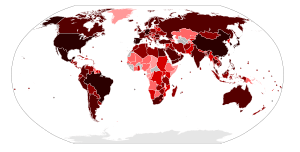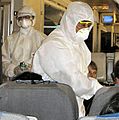2009 flu pandemic facts for kids

50 000+ confirmed cases 5,000+ confirmed cases 500+ confirmed cases 50+ confirmed cases 5+ confirmed cases 1+ confirmed cases
|
|
| Disease | Influenza |
|---|---|
| Virus strain | Pandemic H1N1/09 virus |
| Location | Worldwide except for Antarctica. |
| First case | Possible Central Mexico then the United States |
| Arrival date | January 2009 (Earliest case) |
| Origin | Veracruz, Mexico; North America. |
| Confirmed cases | According to the laboratory (widespread) |
| Suspected cases‡ | 700 million-1.4 billion cases |
| Recovered | Unknown due to the spread have been highly. |
|
Deaths
|
150,000–575,000 (Estaimated 284,000 deaths by the WHO) {Around 18,000 deaths due to the people that did not test} |
|
Territories
|
More than 200 countries. |
| ‡ Suspected cases have not been confirmed as being due to this strain by laboratory tests, although some other strains may have been ruled out. | |
The 2009 flu pandemic or swine flu was an influenza pandemic that lasted from early 2009 to late 2010, and the second of the two pandemics involving H1N1 influenza virus (the first of them being the 1918–1920 Spanish flu pandemic).
First described in April 2009, the virus appeared to be a new strain of H1N1 which resulted when a previous triple reassortment of bird, swine and human flu viruses.
It is said that 11–21% of the then global population (of about 6.8 billion), or around 700 million–1.4 billion people (Suspect cases) had the illness — more than the Spanish flu pandemic.
However, with about 150,000–575,000 fatalities, it had a much lower case fatality rate of 0.01-0.08%.
Images for kids
-
President Barack Obama being vaccinated against H1N1 flu on 20 December 2009
-
Thermal imaging camera and screen, photographed in an airport terminal in Greece. Thermal imaging can detect elevated body temperature, one of the signs of swine flu.
See also
 In Spanish: Pandemia de gripe A (H1N1) de 2009-2010 para niños
In Spanish: Pandemia de gripe A (H1N1) de 2009-2010 para niños








